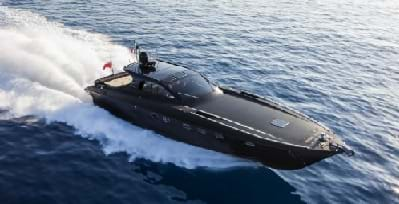Quick Look
Grade Level: Elementary school
Time Required: 45 minutes
Expendable Cost: US $0.50
Group Size: 2
Subject Areas: Earth and Space, Physical Science, Science and Technology
Introduction
Bolded words are vocabulary and concepts to highlight with students during the activity.
Engineers design powerful propellants for launching rockets into space. To design the propellants so they produce enough thrust, they must understand their chemical properties. Factors such as propellant weight must also be considered. Boats can also be powered by propellants! When propellants burn, pressure is created. Releasing this pressure through a small opening generates thrust that can be used to move objects. 
Supplies
For each group:
- 2 Alka-Seltzer® antacid tablets
- 1/2 sheet of blank paper
- 1 film canister (with hole in lid)
- 3-4" (2 cm) piece of foam
Note: If film canisters cannot be obtained, use plastic prescription bottles with non-childproof lids instead.
For class to share (demo):
- 1 roll of paper towels
- 1 12-16 oz. plastic cup
- scissors
- access to sink basin or large plastic tub
- water
- stopwatch
- 1 Alka-Seltzer tablet
- duct tape
Subscribe
Get the inside scoop on all things TeachEngineering such as new site features, curriculum updates, video releases, and more by signing up for our newsletter!Procedure
Procedures Overview
Students explore the concept of thrust using antacid tablets as a propellant for their model boats made from small containers. They try several different ways of using the Alka-Seltzer to propel their boats.
Procedure
- Discuss propellants and some of their uses. Introduce students to today's propellant: Alka-Seltzer and water. In front of students, drop a tablet in a cup of water to show them how it reacts.
- Explain that they will make boats using film canisters (or prescription bottles) that run on Alka-Seltzer tablets. The goal is to have a boat that "propels" as long as possible on one-half tablet.
- Students may use their tablet in any way, provided they only use one-half tablet per trial "run." They may put it in the canister whole, crush it into powder, adjust the amount of water used, change the water temperature, etc.
- Have each group put a fin on its boat (canister/bottle) so that it does not spin wildly: the hole where the propellant exits must stay underwater. (Note: This means that the lid hole must line up with the fin, slightly off center; students should not create more than one hole.)
- Divide the class into student pairs. Give them a few minutes to design the fins for their canisters, as well as brainstorm several ways to use their Alka-Seltzer tablets. While students are designing their fins, fill the basin/tub half full with water to serve as a testing site. Carefully break each Alka-Seltzer tablet in half. Place the half-tablets on a sheet of paper.
- Hand out the supplies to students, excluding the tablets. Give them time to build their fins for their boats. (Each group may use up to four halves for four trial runs – do NOT give out the Alka-Seltzer yet. PLEASE MONITOR the tablets closely!)
- When groups are ready to test their boats, have them come to the basin. Give them a half-tablet, and let them break it up as they see fit (if crushing, fold the tablet in a piece of paper and hit gently with a scissors handle).
- Have students add water to their canisters, then the tablet, then quickly close the lid and place the canister in the water basin, and let go. Note: Remember to help students align the lid hole with the fin.
- Leaders: Start the stopwatch as soon as the canister hits the water, and stop when the canister stops "motoring" around the water.
- Students are welcome to redesign their fins and test up to four propellant mixtures. Have students rinse out their Aqua-Thruster model boats between trials.
Wrap Up - Thought Questions
- Which form of Alka-Seltzer worked the best? Why?
- Did the amount of water used or temperature of the water affect how long the boat was in motion?
- How does Alka-Seltzer surface area affect the reaction of the tablets with water?
- What creates the thrust that propels the boat?
More Curriculum Like This

Students construct small-sized model rocket-powered boats—"aqua-thrusters"—that are made from film canisters propelled by carbon dioxide gas produced from a chemical reaction between antacid tablets and water.

Students learn how rocket thrust is generated with propellant. The two types of propellants are discussed—liquid and solid—and their relation to their use on rockets is investigated. Students learn why engineers need to know the different properties of propellants.

Students acquire a basic understanding of the science and engineering of space travel as well as a brief history of space exploration. They learn about the scientists and engineers who made space travel possible and briefly examine some famous space missions.

Students explore motion, rockets and rocket motion while assisting Spacewoman Tess, Spaceman Rohan and Maya in their explorations. First they learn some basic facts about vehicles, rockets and why we use them. Then, they discover that the motion of all objects—including the flight of a rocket and mo...
Copyright
© 2013 by Regents of the University of ColoradoLast modified: May 12, 2022









User Comments & Tips